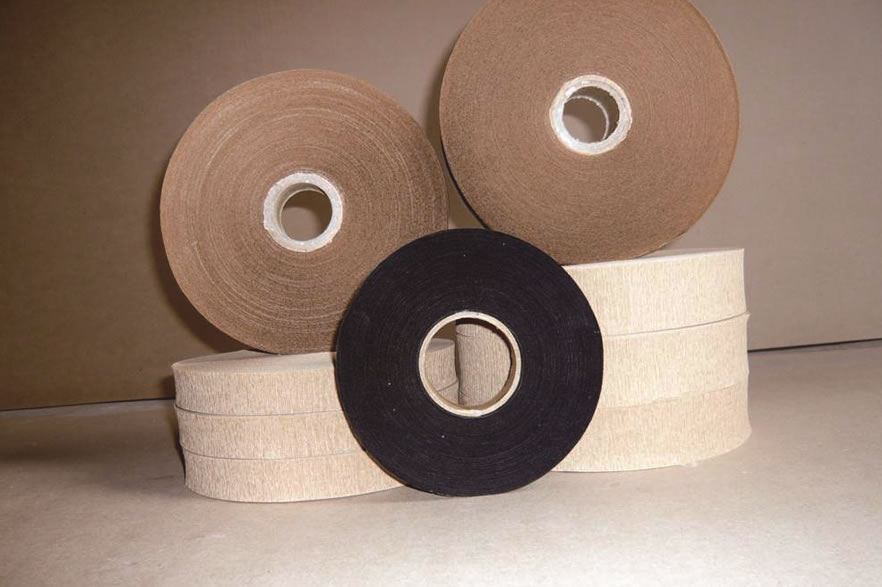Semiconducting Crepe Paper Introduction Semiconducting crepe paper is a functional insulating material that combines...
Controllable Semiconductivity: By adjusting the addition ratio and dispersion uniformity of conductive media (e.g., carbon black), the electrical conductivity can be precisely regulated to meet the charge dissipation requirements of different equipment, avoiding local electric field concentration.
Structural Adaptability: The special “crepe texture” endows it with excellent elasticity and ductility, allowing it to closely adhere to irregular electrical components (such as cable joints and transformer windings) without falling off or cracking even under vibration or temperature changes.
Electrical Compatibility: It exhibits good compatibility with other electrical insulating materials such as transformer oil, insulating paper, and epoxy resin. It does not affect the performance of the overall insulation system due to material reactions, while reducing the partial discharge magnitude at interfaces (usually required to be ≤ 5 pC).
Environmental Stability:
Temperature Resistance: The long-term operating temperature range can cover -40℃ to 120℃ (up to 150℃ for specially modified products), meeting the operating temperature requirements of most power equipment.
Aging Resistance: It is resistant to moisture, heat, and ozone. Under the long-term action of electric fields and temperature, the attenuation of electrical conductivity and mechanical strength is slow, with a service life of over 20 years.
Flame Retardancy: Some products can reach the UL94 V-0 flame retardant standard by adding flame retardants (e.g., aluminum hydroxide), reducing the risk of electrical fires.
Mechanical Strength: The longitudinal tensile strength is ≥ 2.5 kN/m, and the tear strength is ≥ 0.3 kN/m, enabling it to withstand slight mechanical stresses during equipment assembly and operation, preventing insulation failure caused by breakage.

Winding End Insulation: Wrapped around the head and tail ends of transformer windings, it eliminates electric field distortion between the windings and the yoke, prevents partial discharges caused by local electric field concentration, and protects the winding insulating paper (e.g., Nomex paper) from breakdown.
Tap Changer Insulation: Used around the moving and fixed contacts of on-load tap changers, it isolates the contacts from direct contact with transformer oil, dissipates charges generated during contact operation, and reduces arc damage to the insulation system.
Iron Core Ground Protection: Adhered to the grounding part of the transformer iron core, it forms a uniform conductive path, avoiding circulation overheating caused by multi-point grounding of the iron core.
Applicable Voltage Level: 110 kV to 1000 kV. Especially in high-voltage and ultra-high-voltage transformers above 220 kV, it is an indispensable key insulating component.
Cable Intermediate Joints: Semiconducting crepe paper is wrapped around the conductor connection part of cables (e.g., copper-aluminum transition joints) to achieve seamless connection with the semiconducting shielding layer of the cable itself. This eliminates the shielding fault at the joint, avoids electric field concentration at the joint, and prevents joint breakdown.
Cable Terminations: Used in the internal insulation structure of cable terminations (e.g., GIS terminations, porcelain sleeve terminations) to fill gaps inside the terminations, guide uniform charge distribution, and reduce the partial discharge magnitude of terminations during operation.
Applicable Voltage Level: 10 kV to 500 kV.
Current Transformers (CT) / Voltage Transformers (VT): Wrapped around the outer layer of the primary and secondary windings of transformers, it isolates the electric field between the windings and the shell, suppresses partial discharges caused by winding vibration, and ensures the measurement accuracy and operational stability of transformers. It is commonly used in 110 kV to 220 kV transformers.
Dry-type Reactors: Used for interlayer insulation or end insulation of reactor windings. Especially in outdoor dry-type reactors, it can simultaneously play the role of moisture resistance and partial discharge suppression, preventing the insulation performance of reactors from deteriorating due to humidity changes.
High-Voltage Switchgear: For example, in the bus insulation support part of SF₆ gas-insulated switches (GIS), it is adhered between the bus and insulators to balance the electric field distribution.
Capacitors: Used for the insulation at the electrode edges of high-voltage film capacitors, eliminating the electric field tip effect at the electrode edges and extending the service life of capacitors.
Motor Insulation: The stator winding ends of some high-voltage motors (e.g., asynchronous motors above 6 kV) use semiconducting crepe paper for auxiliary insulation to reduce partial discharges when the windings start.
Compatible Medium Selection: When used in conjunction with media such as transformer oil and insulating adhesive, compatibility tests should be conducted in advance to avoid affecting semiconducting properties due to material dissolution or precipitation.
Installation Process Requirements: Uniform tension should be ensured during winding to prevent creasing or breakage of the crepe paper. Otherwise, local electric field concentration points will form, which may instead increase the risk of discharge.
Environmental Control: Storage and installation should be carried out in a dry and clean environment (humidity ≤ 60%, dust-free) to prevent moisture or impurities from adhering and affecting insulation performance.
If you are interested in our products,, please send us a message and we will contact you as soon as we receive it. Email: info@ztaero.com whatsApp: +8616650273778